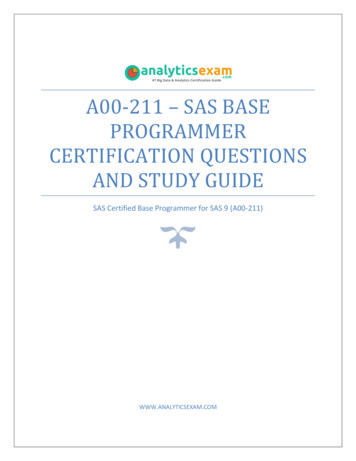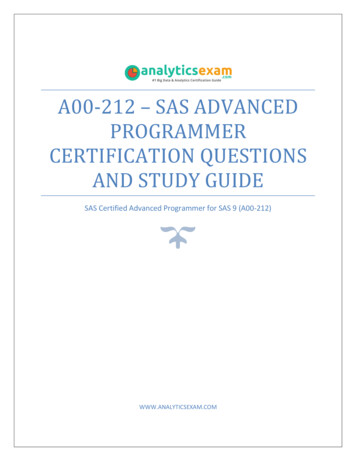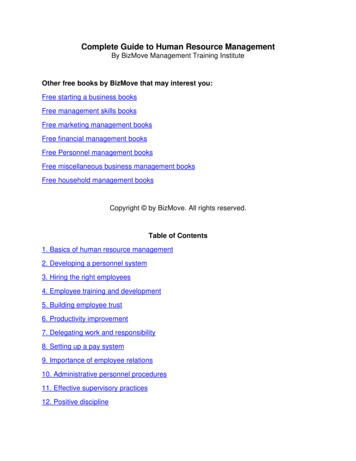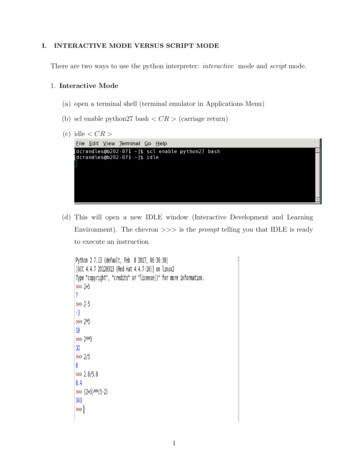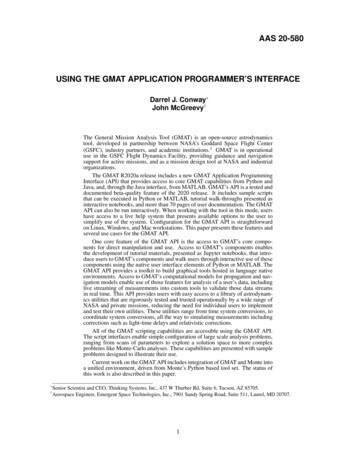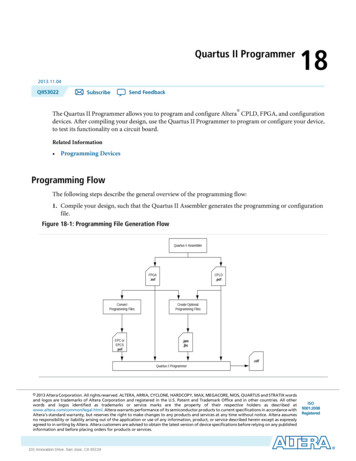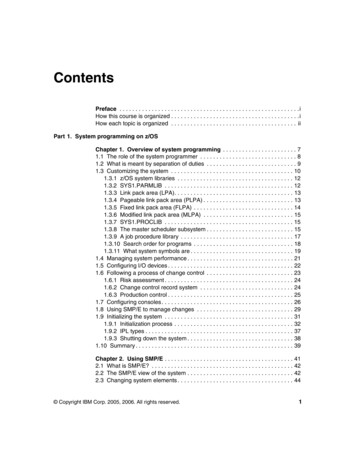
Transcription
www.allitebooks.com
Mastering AngularJS DirectivesDevelop, maintain, and test production-ready directivesfor any AngularJS-based applicationJosh KurzBIRMINGHAM - MUMBAIwww.allitebooks.com
Mastering AngularJS DirectivesCopyright 2014 Packt PublishingAll rights reserved. No part of this book may be reproduced, stored in a retrievalsystem, or transmitted in any form or by any means, without the prior writtenpermission of the publisher, except in the case of brief quotations embedded incritical articles or reviews.Every effort has been made in the preparation of this book to ensure the accuracyof the information presented. However, the information contained in this book issold without warranty, either express or implied. Neither the author, nor PacktPublishing, and its dealers and distributors will be held liable for any damagescaused or alleged to be caused directly or indirectly by this book.Packt Publishing has endeavored to provide trademark information about all of thecompanies and products mentioned in this book by the appropriate use of capitals.However, Packt Publishing cannot guarantee the accuracy of this information.First Published: June 2014Production Reference: 1090614Published by Packt Publishing Ltd.Livery Place35 Livery StreetBirmingham B3 2PB, UK.ISBN 978-1-78398-158-8www.packtpub.comCover Image by Josh Kurz (jkurz25@gmail.com)www.allitebooks.com
CreditsAuthorProject CoordinatorJosh KurzKartik VedamReviewersProofreadersPete Bacon DarwinSimran BhogalLee HowardAmeesha GreenDarius RigginsMaria GouldIwan van StaverenPaul HindleRuoyu SunLinda MorrisCommissioning EditorKunal ParikhIndexerPriya SubramaniAcquisition EditorSubho GuptaGraphicsAbhinash SahuContent Development EditorNeil AlexanderProduction CoordinatorMelwyn D'saTechnical EditorsCover WorkPragnesh BilimoriaMelwyn D'saIndrajit A. DasShashank DesaiCopy EditorsDipti KapadiaInsiya MorbiwalaAditya Nairwww.allitebooks.com
About the AuthorJosh Kurz is a client-side technician who constantly pushes the realms of frontendtechnologies by mixing new-age theories and proven Computer Science concepts.He has successfully shown that AngularJS can be used to create some of the fastest,most usable data visualization applications while working at Turner. He also has atrue passion for open source code and believes it is one of the reasons for his success.Currently, outside of work, he is practicing to become a black belt in Jiu Jitsu.I would like to dedicate this book to the people who helped makethis book a reality. Many of these people are part of the AngularJScommunity and push the bounds of what is conceivable every day.The technical editors of this book all deserve a round of applause,as they have done such a wonderful job. My co-workers at Turneralso help raise the bar every day, showing me what it takes to bea professional. I would also like to thank Invidia Studios for theamazing artwork. Last but not least, my wonderful fiancé deservesthe most appreciation, as she is so patient and caring and has helpedin more ways than I can even begin to express.www.allitebooks.com
About the ReviewersPete Bacon Darwin is a freelance programmer who is currently working with theAngularJS team at Google. He has a degree in Math from Cambridge University. Heworked for a bunch of consulting companies before giving it all up to look after hiskids and do coding in the background.When he isn't coding or parenting, Pete teaches Aikido and wishes he could findtime to do more climbing and mountaineering.Pete co-authored Mastering Web Application Development with AngularJS,Packt Publishing.Darius Riggins is a veteran full-stack developer who focuses on solvingchallenging problems with creative solutions.Ruoyu Sun is a designer and developer living in Hong Kong. He is passionateabout programming and has contributed to several open source projects. He foundedseveral tech start-ups using a variety of technology before going into the industry.He is the author of the book Designing for XOOPS, O'Reilly Media.I would like to thank all my friends and family, who have alwayssupported me.www.allitebooks.com
www.PacktPub.comSupport files, eBooks, discount offers,and moreYou might want to visit www.PacktPub.com for support files and downloads related toyour book.Did you know that Packt offers eBook versions of every book published, with PDF and ePubfiles available? You can upgrade to the eBook version at www.PacktPub.com and as a printbook customer, you are entitled to a discount on the eBook copy. Get in touch with us atservice@packtpub.com for more details.At www.PacktPub.com, you can also read a collection of free technical articles, sign up for arange of free newsletters and receive exclusive discounts and offers on Packt books and eBooks.http://PacktLib.PacktPub.comDo you need instant solutions to your IT questions? PacktLib is Packt's online digital booklibrary. Here, you can access, read and search across Packt's entire library of books.Why subscribe? Fully searchable across every book published by Packt Copy and paste, print, and bookmark content On demand and accessible via web browserFree access for Packt account holdersIf you have an account with Packt at www.PacktPub.com, you can use this to accessPacktLib today and view nine entirely free books. Simply use your login credentials forimmediate access.www.allitebooks.com
Table of ContentsPrefaceChapter 1: The Tools of the Trade19Introduction to directivesDirective Definition Object TranscludeCompileLinkWrapping up definition objectsChapter 2: Building a Stopwatch DirectiveBreaking down the stopwatchStopwatch requirementsThe basics of testingCreation testsWriting the stopwatchStopwatch's business logicBusiness logic testsOptimizing the 24447Stopwatch's filter49Summary50www.allitebooks.com
Table of ContentsChapter 3: Harnessing External JavaScript Librarieswith DirectivesIncorporating third-party librariesTesting directives that use third-party librariesWrapping the gauge.js fileTesting the gauge directiveWriting the gauge directiveWriting scope interaction tests51525455555658Wrapping the fullCalendar.js fileIntroduction to the calendar directiveTesting the fullCalendar directive606062Writing the fullCalendar directiveSummary6469Testing the calendar's initialization and MVC functionalityChapter 4: Compiling the AdvantagesCommon use cases for compiling the DOMUsing transclusion in a directiveUnveiling transclusionCreating recursive directivesThe custom recursive tree directiveUsing transclusion and a templateUrl with the treeNode directiveTesting the treeNode directiveThe treeNodeTemplate directiveThe treeNode directive using only transclusionTesting the treeNode directiveThe treenodeNoTemplate directiveCompiling templates and their many valuesIntroduction to the media player directiveRequirements for the media player directiveTesting the media player directiveWriting the media player directiveBreaking down the media player directiveUtilizing advanced templatesThe mediaelement templatesThe flowplayer 192SummaryChapter 5: Communication between DirectivesTesting integrated directivesIntegration testsUsing scope objects for communicationUsing child scopesCreating a wasFast directive[ ii ]www.allitebooks.com9597979899100102
Table of ContentsUnit testingIntegration testsImplementing the wasFast directive103103105Creating a fastRunner directive106Integration testingImplementing the fastRunner directive108108How to use isolate scopesRelying on the rootScope functionBroadcasting to other directivesCommunicating with media players109113113114Collaborating with controllersRequiring the basicsUsing controllers for the bbPlayer directive117117118Integration testing for the bbBroadcastingPlayer directiveImplementing the bbBroadcastPlayer directiveIntegration testingImplementing the bbPlayer and bbPlayerContainer directivesCreating a fastClicker directiveIntegration testingWriting the fastClicker directiveWiring up the stopwatch114116118119120121122123Summary125Chapter 6: Working with Live Data127Doing a deep watch on rootScope.dataDoing a shallow watch on rootScope.data132132Techniques that drive directivesThe q libraryHow should data be watched for changes?128129131Directives can be in chargeTesting directives that control data134135Writing the bbPhoneDetails directiveWorking with D3140141Summary152Testing bbPhoneDetailsThe YouTube views bar chartThe stockTicker directiveChapter 7: Optimization and Code QualityAngularJS code qualityThe importance of templatesNecessary DOM manipulationsOptimization of the directivesTools for monitoring performanceThe digest cycle[ iii ]www.allitebooks.com135142146153154154155156157157
Table of ContentsLess bindings yield faster resultsSolving the problem with the bbOneBinders directive159160Summary166The bbOneBinders directiveThe bbOneBinders tests161162Chapter 8: Directives and Animations167Chapter 9: Conclusion185Index191Providing animationsCSS-based animationsWorking with ngClass and transitionsWorking with ngClass and animationsWorking with ngIf and transitionsJavaScript-based animationsCustom effeckt.CSS animationsSummaryA directive's building blocksThird-party librariesThe compile cycleTesting directivesDirective intercommunicationQuality and 84185186187187188189189190[ iv ]
PrefaceAngularJS offers a new outlook on web development that is changing more andmore opinions everyday. The reason people are agreeing with AngularJS's directionis because of its orthogonal views on encapsulation and separation. Separation oflogic into structurally defined realms is AngularJS's specialty, and this truth allowsmore focus to be placed on domain specific logic.Directives offer the biggest form of encapsulation inside AngularJS applications.This is true because of its focus on separating the view from the model. For years,developers have combined different types of client-side logic that has no businessbeing coupled together. The decoupling of the view and model has begun to takefull effect in modern web applications, and AngularJS directives have been builtwith this mindset at their core.Many say that directives are the most difficult piece of AngularJS to learn. Peoplesay this because directives take a new approach to JavaScript conventions, whichhas not been done before. There are not many libraries that focus on declarativeapproaches to handle the relationship between HTML and JavaScript. These newconcepts seem difficult at first glance, but once their logic is understood, things fallinto place rather quickly.Many use cases can be solved with a simple directive or a set of directives that workin unison with each other. We will go over how to create these simple directives andhow to train your mind to immediately consider them as solutions. The stages thatthis book goes through build on top of a singular idea. This idea is how to properlytake some data model, and effectively render it and all of its changes in the view.Once directives are understood for what they are, many great use cases can beaccomplished with them. Some of the most important directives are actually builtinto the core itself, with the same tools available to any application. This book showsus how to use the different options made available by AngularJS to create a widerange of directives that serve many different purposes.
PrefaceThe differences between the directives created in this book are pretty broad. Thereare stopwatches, stoplights, media players, and stock charts, which can not onlywork together but also work individually just as well. The only central theme toeach is that they are considered black belt directives and, as such, are tested andimplemented just like any other production-ready software.What this book coversChapter 1, The Tools of the Trade, introduces us to what a directive is, how it is created,and the different options that can be used to create them. Its main purpose is tointroduce directives from a high-level perspective so that anyone can digest theirmeaning. To do this, the chapter is broken down into different parts that consist ofbasic examples showcasing the use of the different options.Chapter 2, Building a Stopwatch Directive, introduces us to the first directive that webuild in this book. The stopwatch building process goes through iterations that shedlight on different design aspects. Throughout the design process, the directive istested thoroughly to prove that its logic is correct and that any change made to itdoes not introduce bugs.Each decision that went into the architecture of the directive is discussed andexplained by showing the change, and then going into details about that change.The overall goal of the chapter is to create a useful directive that can be used in manydifferent applications and to get ideas stirring about your own custom directives.Chapter 3, Harnessing External JavaScript Libraries with Directives, discusses howmany applications rely on third-party libraries to accomplish advanced DOMmanipulation. These libraries can be integrated smoothly with any AngularJSapplication and can still abide by the concepts made by the majority in thecommunity. The purpose of this chapter is to showcase best practices whenintegrating third-party libraries into AngularJS applications.Chapter 4, Compiling the Advantages, shows you how being able to utilize AngularJS'scompile cycle at will is useful in many different instances. There are few use casesthat require the use of the compile service, and these are discussed in detail.This chapter also showcases how useful it can be to generate DOM attached toAngularJS's scope in conjunction with third-party libraries and dynamic templates.Chapter 5, Communication between Directives, shows that directives are very usefulin normal circumstances. They are even more useful when they work in unisonwith each other to accomplish similar tasks. There are many ways to get directivesto work together. Some ways include basic scope inheritance, and others includesharing portions of execution context.[2]
PrefaceThis chapter takes a deep dive into the many possible ways to get directives to workwith each other. No matter what their relationship, there is always a way to get twodirectives to work in collaboration. The examples here also help showcase how to writeintegration tests in order to prove the logic being used to integrate works as desired.Chapter 6, Working with Live Data, shows that data is what makes applicationsimportant. If it were not for the data, then there would be no reason to push theWeb forward. This chapter showcases the philosophies behind developing directivesand their approach to working with live data.Since the data is coming from a live source, we have kept scale in mind throughoutthe design of all of these examples. The scale considerations bring a large focus ondifferent ways to write directives that deal with large amounts of data.Chapter 7, Optimization and Code Quality, shows the importance of making sure thatan application is fast and how the ability to stay agile is detrimental to its lifespan.AngularJS gives us many opportunities to write clean, fast code that does amazingthings. However, with all great things comes great responsibility.AngularJS can be used in inefficient ways that can drastically slow down a web page.This chapter showcases some things to watch out for when writing directives. Sincedirectives are the main reason to create massive amounts of bindings, we go overhow to keep the total number of bindings to a minimum. This chapter also goes overthe benefits that AngularJS brings in terms of quality code and what this means fororganized HTML views.Chapter 8, Directives and Animations, shows why directives play an important rolein how animations are integrated. This is because AngularJS animations have beenbuilt in a way to create another encapsulation layer that plays directly by workingalongside directives. This chapter shows us how to use the animation service in coredirectives and how to create custom directives that use animations.Chapter 9, Conclusion, wraps up the book with an overall summary of closingstatements. There are references made to all the sections of the book, and each isgiven an overview. The overall goal is to finalize the ideas and concepts that havebeen portrayed.What you need for this bookThis book has been written to work with the 1.2.x branch. The directives that havebeen created will work with future versions of AngularJS, but there may be slightchanges that need to occur in these future versions.[3]
PrefaceThe examples that have been built are being showcased at http://angulardirectives.joshkurz.net/ and in the GitHub repo, irectives. The instructions to install theproject can be located in the README file on the GitHub repo and here.The following are the normal requirements for today's project standards: npm install -g grunt-cli http-servernpm installbower installgrunt*grunt protractorAll of the necessary modules are installed via npm. Grunt is used in this projectto create the build file, which is tested against and used in angulardirectives.joshkurz.net. Protractor is used for all E2E tests in this book. To run Protractortests, a web server needs be hosting the files on localhost. It is recommended to usethe npm module http-server. Once you have these packages installed and all of thetests pass, you can play around with whatever you want inside the repo. Please senda PR if you would like to contribute to the project as well.Who this book is forIf you are a developer who has previous JavaScript experience and some AngularJSexperience, this is the book for you. New AngularJS users will be able to followthe concepts of this book, but there may be some references to AngularJS-specificmaterial that is not fully defined in the book.ConventionsIn this book, you will find a number of styles of text that distinguish betweendifferent kinds of information. Here are some examples of these styles, and anexplanation of their meaning.Code words in text, directive names, folder names, filenames, file extensions,pathnames, dummy URLs, user input, and Twitter handles are shown as follows:"The ngInclude directive creates an opportunity to write clean organized views."[4]
PrefaceA block of code is set as follows: routeProvider.when('/mediaelement', ementView.tpl.html',reloadOnSearch: false,controller:'mediaelementCtrl'});When we wish to draw your attention to a particular part of a code block,the relevant lines or items are set in bold: routeProvider.when('/mediaelement', ementView.tpl.html',reloadOnSearch: false,controller:'mediaelementCtrl'});New terms and important words are shown in bold.Warnings or important notes appear in a box like this.Tips and tricks appear like this.Reader feedbackFeedback from our readers is always welcome. Let us know what you think aboutthis book—what you liked or may have disliked. Reader feedback is important forus to develop titles that you really get the most out of.To send us general feedback, simply send an e-mail to feedback@packtpub.com,and mention the book title via the subject of your message.If there is a topic that you have expertise in and you are interested in either writingor contributing to a book, see our author guide on www.packtpub.com/authors.[5]
PrefaceCustomer supportNow that you are the proud owner of a Packt book, we have a number of things tohelp you to get the most from your purchase.Downloading the example codeYou can download the example code files for all Packt books you have purchasedfrom your account at http://www.packtpub.com. If you purchased this bookelsewhere, you can visit http://www.packtpub.com/support and register to havethe files e-mailed directly to you. You can also download the code from GitHub atany time by going to rectives.ErrataAlthough we have taken every care to ensure the accuracy of our content, mistakesdo happen. If you find a mistake in one of our books—maybe a mistake in the text orthe code—we would be grateful if you would report this to us. By doing so, you cansave other readers from frustration and help us improve subsequent versions of thisbook. If you find any errata, please report them by visiting http://www.packtpub.com/submit-errata, selecting your book, clicking on the errata submission form link,and entering the details of your errata. Once your errata are verified, your submissionwill be accepted and the errata will be uploaded on our website, or added to any list ofexisting errata, under the Errata section of that title. Any existing errata can be viewedby selecting your title from http://www.packtpub.com/support.PiracyPiracy of copyright material on the Internet is an ongoing problem across all media.At Packt, we take the protection of our copyright and licenses very seriously. If youcome across any illegal copies of our works, in any form, on the Internet, pleaseprovide us with the location address or website name immediately so that we canpursue a remedy.Please contact us at copyright@packtpub.com with a link to the suspectedpirated material.We appreciate your help in protecting our authors, and our ability to bring youvaluable content.[6]
PrefaceQuestionsYou can contact us at questions@packtpub.com if you are having a problem withany aspect of the book, and we will do our best to address it.[7]
The Tools of the TradeThe leading edge of web development moves quicker than most mortal humanscan keep up with. There are so many different techniques to learn and harness thatit can sometimes seem overwhelming. Thankfully, there is a wonderful JavaScriptframework called AngularJS that helps us mere mortals become something greater.AngularJS offers many different facets of technology that can be used to accomplishdifferent tasks efficiently and effectively. There is no specific implementation thatAngularJS is built from that is more powerful than a directive. A directive may bedefined as an official or authoritative instruction. This is a modern nontechnical termfor a directive. In AngularJS, directives still follow this definition; however, a moretechnical description could be a set of instructions, the ultimate goal of which is toread or write HTML.Directives can be used to solve many different use cases related to Document ObjectModel (DOM). Directives allow developers to create new HTML elements that cando almost anything inside AngularJS. Teaching the browser new functionality toprovide DOM manipulation, creation, and event detection is a new idea that is justbecoming popular.AngularJS takes a different approach to how JavaScript and HTML5 work in unisonwith each other. There is no longer a need to constantly traverse the DOM tree forevery bit of functionality that needs to be created. Directives allow for a declarativeapproach, which separates DOM manipulation logic and business logic. Thisseparation means that our new applications are more readable, testable, andperform better.www.allitebooks.com
The Tools of the TradeIntroduction to directivesWhen first learning about AngularJS, directives can create a magical illusion that hidesthe logic associated with the view's actions. This hidden logic is by design and is thereason AngularJS is so popular. The gory details of every directive are not importantto some developers, but these details are the lifeblood of custom directives.A directive is essentially just a JavaScript factory function that is defined insideof a given AngularJS module. The function returns an object that holds a set ofinstructions for the AngularJS HTML compiler. This object can either be a functionthat is run once the element is linked to the scope (link function) or a JSONrepresentation of more advanced instructions that ultimately should also contain alink function. Returning a JSON instruction representation is referred to as returninga definition object and is the community-preferred method of writing directives.Definition objects can have a finite number of options, made available by theAngularJS public directive API. Let's break down a simple definition object as follows:var definitionObject {restrict: 'EA',link: function(scope, element, attrs){element.text('Hello Directive World');}};Downloading the example codeYou can download the example code files for all Packt books that youhave purchased from your account at http://www.packtpub.com.If you purchased this book elsewhere, you can visit http://www.packtpub.com/support and register to have the files e-maileddirectly to you. The code can also be found at irectives/tree/master/chapters.This definition object has two properties that instruct the AngularJS compiler to dospecific tasks. These instructions state that the directive can only be created on anelement or attribute, and once it's found, to set its text to 'Hello World'. The specificsyntax needed to add this directive to the AngularJS compiler is as follows:app.directive('bbHelloWorld', function(){return definitionObject;});[ 10 ]
Chapter 1The directive is named bbHelloWorld because we are namespacingall of our directives with bb. This is a community-preferred method ofdirective writing because creating reusable code that does not interferewith other applications is the goal.Now that our directive has been created, we can use it in any HTML template thatis part of our ng application. To call this directive, we write something like thefollowing lines of code: bb-hello-world /bb-hello-world The output will be as follows:Hello Directive WorldThis was an example of the most basic type of directive. There is nothing wrongwith creating simple directives that accomplish basic tasks, but AngularJS allows forall levels of directives to be written. The complete Definition Object API should beunderstood to create more advanced directives.Directive Definition Object APIThe compiler is given instructions from the directive's definition object. Theseinstructions can be integers, strings, booleans, or JavaScript objects. Their purposeis to give the developer many different options of control when initializing anddynamically manipulating DOM according to the given model.PriorityThe priority integer is used when multiple directives are set on the same element.AngularJS collects all of the known directives on an element by any of the definedrestrict properties and runs each directive's compile, prelink, and postlinkfunctions in a given order. The order is specified by priority. Lower prioritycompile and prelink functions are run last; however, the postlink function is theopposite. The default value is zero. Negative values are allowed in case directivesneed to be compiled after default directives.TerminalThe terminal field is a Boolean whose default value is false. The terminal valueof a directive applies to lower priority directives defined on the same elementand all of their child directives. Setting a terminal field to true states that theapplicable directives will not compile during the initial directive collection.The initial collection can be run in AngularJS during the initial bootstrap ora manual compile function call.[ 11 ]
The Tools of the TradeAn HTML example looks like the following: div directive-one directive-two directive-three directive-four /directive-four /div The following code snippet shows how the directive definition of a terminaldirective looks:app.directive('directiveTwo', function() {return {priority: 10,terminal: true,link: function(scope,element,attrs) {//link logic}}});If directiveOne and directiveThree have a priority lower than 10, then they willnot run on this given div element. The directiveFour directive will not run becauseit is a child of the terminal directive. Just because these elements have not been runduring the initial collection phase does not mean that they cannot be run at a latertime, depending upon other directive definition objects that could have been set.The terminal option is used in the core library by a few differentdirectives. The most notable are ngRepeat, ngIf, and ngInclude.ScopeA scope is a JavaScript object that is created by AngularJS during the initialbootstrap. This initial scope is referred to as the rootScope directive and can becreated in two different ways. The ngApp directive or angular.bootstrap can becalled on an element. Either way, the result is the same.Once the application has been bootstrapped and a rootScope directive has beencreated, subsequent child directives are in charge of creating new types of scopes.Together, these new scopes create a hierarchy of communication channels. Thereare specific rules for how each channel is allowed to communicate with each other.[ 12 ]
Chapter 1The following two different types of scopes denote the communication rules that areobserved by the scope hierarchy: The child scope The isolate scopeThese two scope objects have different types of communication abilities. Childscopes are created using normal JavaScript prototypal inheritance, which meansthey inherit their parents' attributes but have their own context. Isolate scopes createa separate context that only has a root scope as a commonality between itself and itsdefining scope.The scope is what drives a directive's ability to keep its view in sync with itsassociated data models. The scope can hold any number of data models and caneither watch their values for changes or just read from them. There are three differentoptions available when creating new
Free access for Packt account holders If you have an account with Packt at www.PacktPub.com, you can use this to access PacktLib today and view nine entirely free books. Simply use your lo
